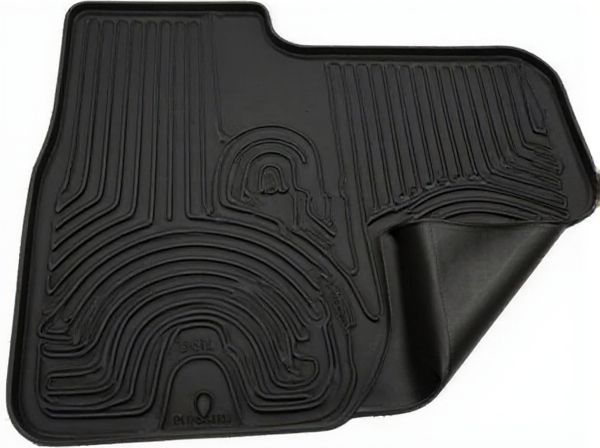
Photo illustration: Thermoplastic Elastomer Mat vs Rubber Mat
Thermoplastic elastomer mats offer superior flexibility, durability, and resistance to chemicals compared to traditional rubber mats. You benefit from easier recycling and quicker manufacturing processes with thermoplastic elastomers, making them an eco-friendly and cost-effective choice. Rubber mats excel in high-temperature resistance and provide excellent cushioning, making them ideal for heavy-duty industrial applications.
Table of Comparison
| Feature | Thermoplastic Elastomer (TPE) Mat | Rubber Mat |
|---|---|---|
| Material Composition | Thermoplastic elastomers blend | Natural or synthetic rubber |
| Durability | High resistance to wear, tear, and chemicals | Very durable but can crack over time |
| Flexibility | Flexible and easy to shape | Less flexible, prone to stiffness |
| Water Resistance | Excellent, waterproof with quick drying | Waterproof but may retain moisture |
| Ease of Cleaning | Simple to clean with water and soap | Also easy but may absorb stains |
| Environmental Impact | Recyclable and eco-friendly | Often less eco-friendly, harder to recycle |
| Cost | Moderate price point | Usually low to moderate cost |
| Grip and Safety | Strong anti-slip surface | Good grip but can become slippery if worn |
| Odor | Low odor or odorless | May emit strong rubber smell |
Introduction to Thermoplastic Elastomer Mats and Rubber Mats
Thermoplastic elastomer mats combine the flexibility and durability of rubber with the processability of thermoplastics, offering excellent resistance to abrasion, chemicals, and temperature variations. Rubber mats, made from natural or synthetic rubbers, provide superior elasticity, cushioning, and shock absorption ideal for industrial and commercial applications. Both materials are widely used for protective flooring, but thermoplastic elastomer mats excel in recyclability and ease of fabrication, whereas rubber mats deliver enhanced resilience and grip.
Composition and Material Differences
Thermoplastic elastomer mats are made from a blend of polymers, combining the elastic properties of rubber with the processability of plastics, allowing them to be melted and reshaped multiple times. Rubber mats, composed primarily of natural or synthetic rubber polymers, offer superior elasticity and resilience but lack the thermoplastic's ability to be remolded after curing. The fundamental material difference lies in thermoplastic elastomers' reversible thermal bonding compared to rubber's cross-linked polymer chains, which give each mat distinct performance characteristics for varied applications.
Durability and Longevity Comparison
Thermoplastic elastomer mats offer superior durability with high resistance to abrasion, chemicals, and UV exposure, making them ideal for long-term use in harsh environments. Rubber mats, while providing excellent flexibility and shock absorption, tend to degrade faster due to susceptibility to oils, ozone, and temperature fluctuations. The longevity of thermoplastic elastomer mats significantly exceeds that of rubber mats, resulting in lower maintenance costs and extended service life.
Comfort and Cushioning Properties
Thermoplastic elastomer mats offer superior cushioning and shock absorption due to their flexible polymer structure that adapts to pressure points, enhancing overall comfort during prolonged use. Rubber mats provide excellent durability and firm support, but tend to be denser, resulting in less compressibility and reduced comfort over time. The lightweight and resilient nature of thermoplastic elastomers makes them ideal for environments requiring prolonged standing or impact protection, outpacing traditional rubber mats in comfort performance.
Slip Resistance and Safety Features
Thermoplastic elastomer mats offer superior slip resistance due to their high coefficient of friction and enhanced flexibility, making them ideal for environments requiring optimal traction and safety. Rubber mats provide excellent shock absorption and durability but may lose grip over time when exposed to oils or water, potentially compromising safety. Both materials incorporate anti-slip textures and resistance to wear, but thermoplastic elastomers generally maintain better performance in wet or oily conditions, ensuring enhanced user safety.
Environmental Impact and Sustainability
Thermoplastic elastomer (TPE) mats are more environmentally sustainable than rubber mats due to their recyclability and lower carbon footprint during production. Rubber mats, especially natural rubber, involve deforestation and higher greenhouse gas emissions, while synthetic rubber often relies on non-renewable petroleum resources. TPE mats also offer better potential for reuse and reduce landfill waste, aligning with circular economy principles.
Maintenance and Cleaning Requirements
Thermoplastic elastomer (TPE) mats require minimal maintenance due to their resistance to stains, UV rays, and chemicals, making them easy to clean with just soap and water. In contrast, rubber mats may demand more frequent cleaning and specialized treatments to prevent cracking, fading, or odor retention. Both materials benefit from regular sweeping and occasional washing, but TPE mats offer superior durability and quicker drying times, reducing maintenance efforts overall.
Cost Effectiveness and Value
Thermoplastic elastomer (TPE) mats offer superior cost effectiveness due to their recyclability and lower manufacturing expenses compared to traditional rubber mats, which are often more costly because of natural rubber sourcing and processing. TPE mats provide excellent durability and flexibility with reduced maintenance costs, delivering enhanced value over the lifespan of the product. While rubber mats may excel in heavy-duty applications, TPE mats balance performance and affordability, making them a preferred choice for budget-conscious industries.
Applications and Best Use Cases
Thermoplastic elastomer (TPE) mats excel in applications requiring flexibility, chemical resistance, and ease of recycling, making them ideal for automotive seals, medical devices, and consumer products. Rubber mats are preferred in heavy-duty environments needing superior abrasion resistance, impact absorption, and high durability, such as gym flooring, industrial anti-fatigue mats, and outdoor weather-resistant surfaces. Choosing between TPE and rubber mats depends on the specific use case requirements for performance, environmental exposure, and lifecycle sustainability.
Which Mat Should You Choose?
Thermoplastic elastomer mats offer superior flexibility, durability, and resistance to chemicals, making them ideal for dynamic environments requiring frequent cleaning and maintenance. Rubber mats excel in shock absorption, slip resistance, and thermal insulation, making them suitable for heavy-duty industrial applications and outdoor use. Choosing between a thermoplastic elastomer mat and a rubber mat depends on specific requirements such as exposure to chemicals, load-bearing capacity, and environmental conditions.
 caratoz.com
caratoz.com